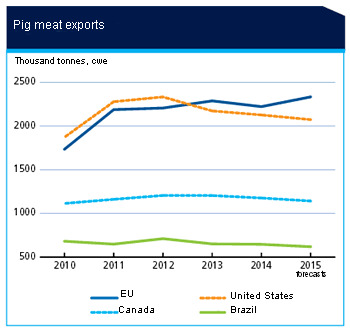According to the FAO Food Outlook, world meat production is anticipated to record a modest 1.1 percent expansion in 2015, to 318.8 million tonnes, with the largest increases expected in the EU, the United States and the Russian Federation. The poultry sector is forecast to drive the global expansion, followed by pig meat. Only modest gains are foreseen in bovine and ovine meat production.
Pork production to grow in all regions
- Stagnation in China , which accounts for almost half the world output, is the main reason for the slowdown. An unfavourable feed-pork price ratio in the country and new environmental regulations have caused farmers to reduce breeding sows, stalling growth. Production in 2015 is projected at 57.1 million tonnes, down 0.2 percent from the previous year.
- Elsewhere in Asia, Vietnam , the Philippines and Indonesia are expected to boost output. Production in Japan and the Republic of Korea continues to be affected by last year’s outbreaks of porcine endemic diarrhoea (PED), which reduced piglet numbers. Both countries may see production rise only during the latter part of 2015 – resulting in little increase in output for the year as a whole.
- Recovery from the effects of PED has been faster in the United States , where production may finish the year 6.1 percent higher, at 11 million tonnes, and Mexico , where production is forecast to rise 3.9 percent to 1.3 million tonnes. In both cases, lower feed prices have encouraged growth.
- Elsewhere in the Americas , a fall in feed costs is anticipated to boost production in Canada and Brazil.
- The EU is expected to maintain the expansion seen last year, based on both augmentation of the breeding sow herd and heavier slaughter weights.
- In the Russian Federation , the pace of growth in pigmeat production is anticipated to increase, due to investment in, and the growing importance of, large-scale production units.
Trade to fall for the third year

Trade in pigmeat in 2015 is expected to decline for the third consecutive year, retreating by 0.6 percent to 7 milliontonnes, although the extent of the decrease would be less than in the previous two years. The major factor contributing to the drop is reduced import demand by the Russian Federation.

- In the Russian Federation, increasing domestic production means that the sourcing of external supplies of pigmeat has been declining since 2012, when imports peaked at 1 089 million tonnes. This process was exacerbated in August 2014 by the implementation of country-specific import bans. As a consequence, deliveries to the Federation are projected to be in the order of 297 000 tonnes in 2015, down 45 percent from 2014 and a fall of two-thirds compared with 2012. While overall purchases have been significantly reduced, Russian imports from some countries not subject to the ban have risen, principally Brazil and Belarus, but also Chile and Serbia. Imports by Japan , Vietnam and Angola are also expected to decline.
- By contrast, a number of countries are anticipated to increase their purchases of pigmeat, including the United States , the Republic of Korea , Mexico , China and Australia , although not sufficiently to counteract the decline elsewhere.
- Apart from the EU , all other major exporters – the United States , Canada and Brazil – are forecast to see retrenched shipments in 2015, as a result of an overall weakening of international demand for pigmeat. In the case of the EU, strong growth in production and competitive pricing are anticipated to lead to a 5 percent increase in sale.
- A more detailed examination of trade data reveals that the affected exporters are adjusting to the ban imposed by the Russian Federation and seeking alternative markets. For example, the EU has reoriented its exports to Asia , but also to Africa , Oceania and North America . Similarly, subsequent to the ban, Canada has increased sales to the United States, Mexico, Oceania and South Africa.
Thursday October 8, 2015/ FAO.
http://www.fao.org



